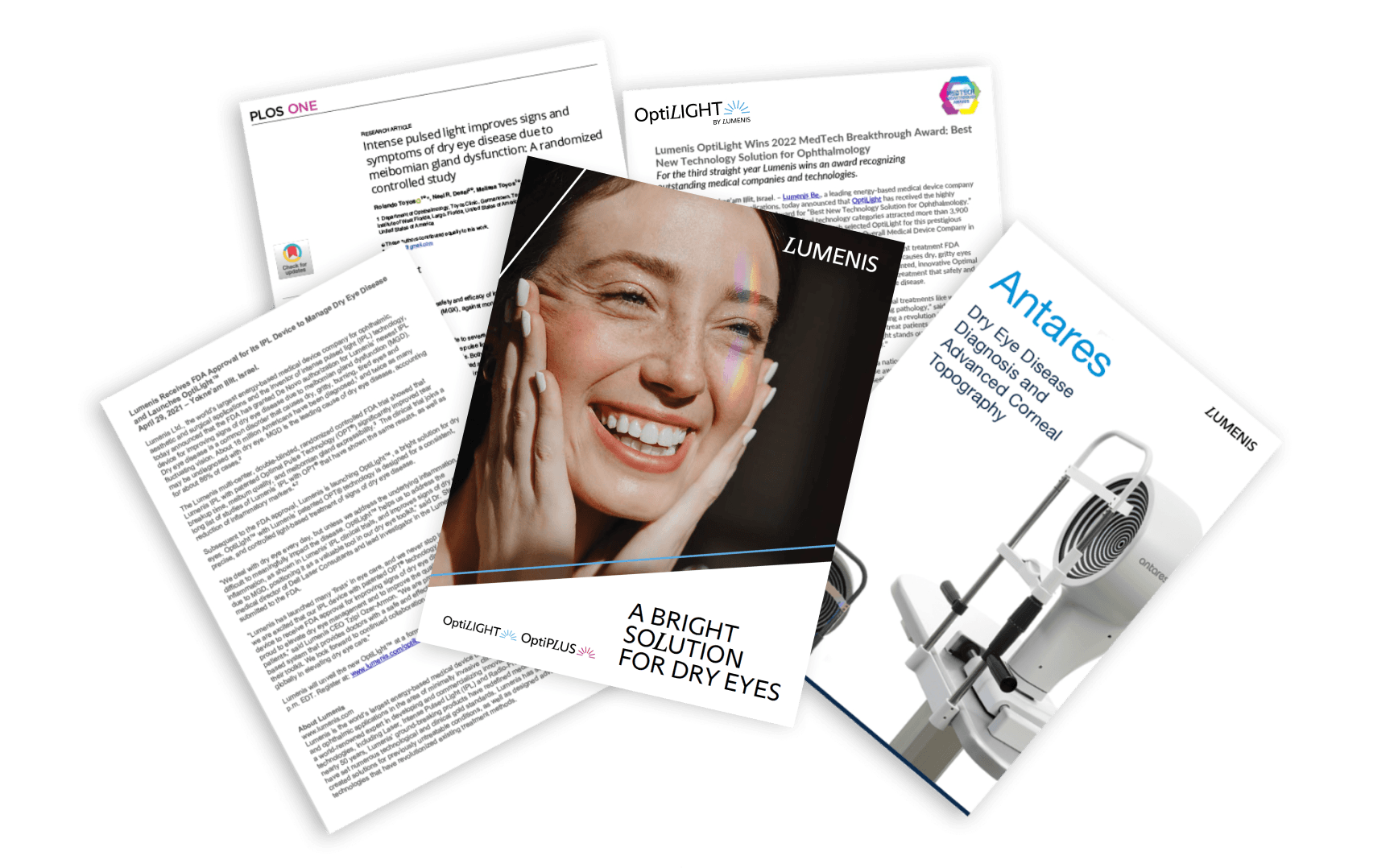Celebrating Excellence: Growing Your Dry Eye Practice with Lumenis Technology

Dry eye is the number one disease we see in our eye care practice every day. In the past, we relied on lubrication and other short-term options to remedy the problem. But now, with OptiLIGHT, we can address key contributing factors of dry eye disease (DED) and deliver impactful results to our patients, enabling us to earn their trust while simultaneously growing our practice.
In 2019, I helped lead the effort to advance the optometric scope of practice in Arkansas, which led to legislation permitting new procedures. Following the scope expansion, I chose to partner with Lumenis to bring its technology into our practice because I trusted the brand and saw the company’s support of optometry and private practices around the country.
At that time, we offered several dry eye treatment options—and still do—but we viewed OptiLIGHT as a major technological advancement we wanted to invest into improving signs of dry eye for patients with MGD for patients with meibomian gland dysfunction (MGD).1,2 Lumenis light therapy is the first and only FDA-approved light therapy for dry eye management, so there wasn’t any question that OptiLIGHT was the right choice for our practice and patients.
Offering OptiLIGHT Treatment to Patients
When assessing a patient, we ask targeted questions at the start of each eye exam to help determine the best treatment strategies. Many patients don’t realize they have dry eye disease and confuse symptoms like watery eyes with other conditions. When we identify clogged glands and inflammation, we discuss intense pulse light (IPL) therapy as a treatment option.3,4 For established patients who have had persistent dry issues for years, we recommend OptiLIGHT right away. Using the Antares diagnostic tool from Lumenis, we show patients a photo of their meibum, compare it to a healthy example, and explain how IPL treatment can help get them there.
Patients receive four treatments, once every two to four weeks, with follow-up maintenance. We offer these OptiLIGHT treatments in a bundle and encourage our patients to invest in that bundle upfront. While some patients can pay per treatment and will feel relief after only one or two sessions, we emphasize that the full course of four will lead to the best results.
We also provide an upgradable package that includes aesthetical treatments in addition to the dry eye treatment, as well as individual treatments to remove lesions or sunspots around the eyes. Our patients appreciate the aesthetic benefits of OptiLIGHT, particularly in evening out their complexions and addressing signs of sun damage and photo-aging. Offering combined ocular and aesthetic treatments not only benefits our patients but also enhances the efficiency of our practice’s workflow and boosts our revenue.
Patient Growth and Outcomes
My practices are in small, rural communities, so we were initially concerned that patients would be hesitant to pay for OptiLIGHT treatment. However, our worries turned out to be unfounded. So many people struggle with dry eye, which significantly affects their daily lives, and they’re willing to do what it takes to improve their quality of life.5 When we describe how OptiLIGHT works, its results, and the relief it can provide, we rarely see any resistance to moving forward with the recommended treatment. Our patients have been thrilled with the results.
The majority of our success in marketing OptiLIGHT to patients comes from referrals. I am a big believer in organic growth. While we promote OptiLIGHT on our website, through emails, ads, and social media, word-of-mouth from patients who have experienced the results firsthand goes a long way.
Since installing OptiLIGHT, we have seen continuous growth in our number of new patients and our profitability each month, which has led to the addition of more doctors to the practice.
Taking the Next Step with OptiPLUS
This summer, we plan to take our dry eye treatment protocol one step further by adding OptiPLUS, a complementary treatment to OptiLIGHT and the first dual-frequency RF technology of its kind. We sought an aesthetic-based modality and again found Lumenis to be the best option. When paired with OptiLIGHT, OptiPLUS enhances clinical results by precisely delivering heat across skin tissue layers to target the meibomian glands and boost collagen production.6,7,8
We are currently determining how to package these treatments together, focusing first on our OptiLIGHT patients who believed in the technology early on. We hope they will spread the word to their family, friends, and neighbors once they experience the added benefits of incorporating OptiPLUS into their treatment plan.
Final Thoughts
Celebrating excellence in a dry eye practice means prioritizing patient care. Our goal is to ensure patients don’t need to travel to a larger city for better treatment. Through our dry eye clinic, they can receive the best possible care right in their hometown.
For other dry eye specialists considering an investment for their own practice, my advice is to jump in headfirst. Technologies like OptiLIGHT and OptiPLUS greatly benefit our patients, and if we don’t embrace them, we’re not providing the most advanced care. When a treatment provides life-changing relief for patients, it will not only grow your practice but also boost staff morale, making it a worthwhile investment for all.
Matthew Jones, O.D., has been practicing optometry in Arkansas since 2009. He has clinics in Blytheville, Osceola, West Memphis, and Paragould. Dr. Jones is Board-Certified by the American Board of Optometry and was recognized as the American Optometric Association’s “Optometrist of the Year” in 2024. He is active on several committees of the Arkansas Optometric Association, working to effect change through state and national legislation, and helped lead scope expansion efforts in Arkansas.
Website: harriseyeclinic.com
LinkedIn: https://www.linkedin.com/in/matthew-jones-o-d-748bb18a/
Discover new
possibilities
Download OptiLIGHT and OptiPLUS info kit

Explore Other Resources
1 Toyos R, Desai NR, Toyos M, Dell SJ. Intense pulsed light improves signs and symptoms of dry eye disease due to meibomian gland dysfunction: A randomized controlled study. PLoS One. 2022;17(6):e0270268. Published 2022 Jun 23. doi:10.1371/journal.pone.0270268
2 Yin Y, Liu N, Gong L, Song N. Changes in the Meibomian Gland After Exposure to Intense Pulsed Light in Meibomian Gland Dysfunction (MGD) Patients. Curr Eye Res. 2018;43(3):308-313. doi:10.1080/02713683.2017.1406525
3 Liu, R., Rong, B., Tu, P., Tang, Y., Song, W., Toyos, R., Toyos, M., & Yan, X. (2017). Analysis of cytokine levels in tears and clinical correlations after intense pulsed light treating meibomian gland dysfunction. American Journal of Ophthalmology, 183, 81-90. https://doi.org/10.1016/j.ajo.2017.08.021
4 Yin Y, Liu N, Gong L, Song N. Changes in the Meibomian Gland After Exposure to Intense Pulsed Light in Meibomian Gland Dysfunction (MGD) Patients. Curr Eye Res. 2018;43(3):308-313. doi:10.1080/02713683.2017.1406525
5 Tutt R, Bradley A, Begley C, Thibos LN. Optical and visual impact of tear break-up in human eyes. Invest Ophthalmol Vis Sci. 2000;41:4117-4123.
6 Javate, R. M., Cruz, R. T. Jr., Khan, J., Trakos, N., & Gordon, R. E. (2011). Nonablative 4-MHz dual radiofrequency wand rejuvenation treatment for periorbital rhytides and midface laxity. Ophthalmic Plastic and Reconstructive Surgery, 27(3), 180-185. doi: 10.1097/IOP.0b013e3181fe8e5a
7 Al-Atif, H. (2022). Collagen supplements for aging and wrinkles: A paradigm shift in the fields of dermatology and cosmetics. Dermatology Practical & Conceptual, 12(1), e2022018. https://doi.org/10.5826/dpc.1201a18
8 Chelnis, J., Garcia, C. N., & Hamza, H. (2023). Multi-frequency RF combined with intense pulsed light improves signs and symptoms of dry eye disease due to meibomian gland dysfunction. Clinical Ophthalmology, 17, 3089-3102. https://doi.org/10.2147/OPTH.S426564
PB-00083760 Rev A